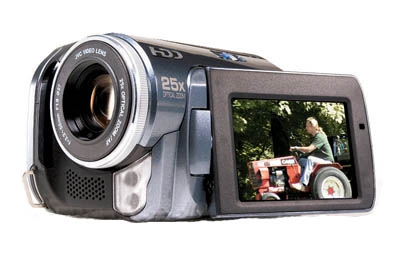Cutting-Edge Camcorders Page 2

JVC Everio GZ-MG30 Hard-Drive Camcorder
When I reviewed JVC's first Everio camcorder ("The Cutting Edge," December 2004), my biggest complaint was that its 4-gigabyte (GB) MicroDrive restricted you to just an hour of best-quality video, and a spare drive - unlike the MiniDV tapes used in most digital camcorders - was neither cheap nor widely available. For its new G-series, JVC has eliminated the removable MicroDrive and replaced it with an embedded 1.8-inch hard drive, the same size drive that made the Apple iPod famous. With its 30-GB capacity, the Everio GZ-MG30 lets you record from 7 to 37 hours of video. So even at the highest quality, it's unlikely that you'll run out of recording time, even on a week-long family trip. Once you're done recording, you hook the Everio up to a Windows or Macintosh computer to transfer your videos for editing and burning to DVD.
 OPERATION Working the Everio is pretty simple. You set the mode switch to shoot MPEG-2 video or still images. Using the menu button and flip-out LCD viewscreen, you can set the video quality. The default mode, Ultra Fine, records 720 x 480 pixels at 8.5 megabits per second (Mbps), which yields the 7 hours maximum. The Fine, Normal, and Economy modes capture 101/2, 14, and 37 hours, respectively. Economy, which is pretty much useful only for uploading video to the Internet, drops the resolution to 352 x 240 pixels and the bit rate to 1.5 Mbps, adequate in a window on a computer but crummy filling a TV screen. If you expect to watch your production on a widescreen TV, you can record in 16:9.
OPERATION Working the Everio is pretty simple. You set the mode switch to shoot MPEG-2 video or still images. Using the menu button and flip-out LCD viewscreen, you can set the video quality. The default mode, Ultra Fine, records 720 x 480 pixels at 8.5 megabits per second (Mbps), which yields the 7 hours maximum. The Fine, Normal, and Economy modes capture 101/2, 14, and 37 hours, respectively. Economy, which is pretty much useful only for uploading video to the Internet, drops the resolution to 352 x 240 pixels and the bit rate to 1.5 Mbps, adequate in a window on a computer but crummy filling a TV screen. If you expect to watch your production on a widescreen TV, you can record in 16:9.
In any mode, the supplied battery records for about an hour on a 1.5-hour charge (larger-capacity battery packs are available). Before shooting, you can also choose whether you want to save your video or stills to the hard drive or to your own SD card inserted at the bottom of the cam. The default for both is the hard drive, but I redirected still photos to a 512-MB card.
When you stop recording a scene, you get the option to delete it or instantly play it from the beginning. The LCD fills up with thumbnails showing the first frame of every scene you've shot, and navigating to any one of them is quick. The G-series includes a front-mounted LED to illuminate close-up scenes for shooting video or photos in dim or no light. You'll use it sparingly, though, since it drains the battery and reaches only a couple of feet.
The Everio has several other nice features, including a drop detector that turns off the power automatically to protect the content on your hard disk from colliding with the read/write head if the camera senses it's falling. (This function can be defeated if you plan to go skydiving.) The multipurpose zoom lever serves as a 25x optical zoom and as the volume control for the built-in speaker when you play videos.
PERFORMANCE During the last week of summer, I threaded the Everio to a 6-inch tripod and positioned it by my neighbor's pool to make two short videos: I Was a Secretary for IBM, my neighbor's recollections of working at Big Blue after World War II (as told in her bathing suit), and Pool Boy, a record of my struggle to regain control of the pool from swimming frogs and floating leaves. The Everio performed flawlessly throughout, perfectly capturing all the action and natural sound as I hurled frogs from the chlorinated water with a long-poled skimmer net. My biggest complaint was the startup time - a long 8 seconds from powering on until you can actually begin recording (including a nondefeatable JVC logo animation on the LCD). If your kid is coming up to bat, better make sure the camera is already in standby mode. A secondary complaint is that the tiny play button is cramped at the center of a navigational diamond, making it too easy to select the wrong thumbnail when your finger strays off center.
As for quality, the Ultra Fine video mode is what you'd expect from DVD recordings, and the Dolby Digital stereo sound, which is recorded at 384 kilobits per second (kbps) for all modes except Economy (where it drops to 128 kbps), was crisp. The camera's stereo mike had no trouble picking up the sound of crickets, rippling water, and even a distant tractor.
- Log in or register to post comments




































































